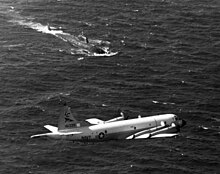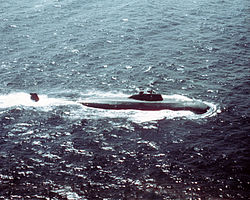Project 671
|
||||||||||||||
|
||||||||||||||
|
||||||||||||||
|
||||||||||||||
|
||||||||||||||
Project 671 “Jorsch” (Ёрш, Russian for perch ), designated by NATO as the Victor I class , was a series of Soviet nuclear submarines during the Cold War . These nuclear powered fighter submarines ( SSN ) were first put into service by the Soviet Navy in 1967.
Development and construction
When the USSR realized that a special nuclear-powered hunting submarine had to be developed, planning for such a submarine began in 1958. The initial requirement was to develop a boat with 2000 tons of water displacement and a maximum diving depth of at least 300 m. A main propulsion system was chosen that consisted of two pressurized water reactors of the OK-300 type and only one propeller. The reactors provided power to a submarine for about eight years before they had to be replaced. Two diesel generators with 200 kW each were also available for charging the batteries. Two electric motors with 275 HP each acted as a reserve or emergency drive, which could operate two small propellers arranged parallel to the screw of the main drive. The Victor class was designed as a double-hulled boat and a shape was chosen for its hull shape that came close to a drop of water in order to generate as little resistance as possible under water.
The armament should not only be effective against enemy submarines, but also against large surface ships and coastal targets and so, in addition to conventional 533 mm torpedoes, three boats were also used for the use of so-called missiles with RPK-2 “Vjuga” (Вьюга , Russian for snowstorm). The boats modified in this way were given the designation Project 671B.
After the first boat of the class, K-38, was put into service in 1967, 14 more boats were launched by 1974. They were all clearly superior to their American counterparts in terms of speed and armament, but were easy to locate due to their enormous noise development and the better sonar sensors of the Americans. However, this was not yet clear to the planners of the Soviet Navy.
All boats were decommissioned in the 1990s and are now being scrapped , partly financed by the G8 countries. The boats are divided into three sections. While bow and stern sections can be scrapped, the reactor section must be safely stored for years before dismantling can begin.
| tact. number | Shipyard | Project | Keel laying | In service since | decommissioned | Remarks |
|---|---|---|---|---|---|---|
| K-038 | Admiralty shipyard | 671 | 04/12/1963 | 05/11/1967 | 1992 | - |
| K-369 | Admiralty shipyard | 671 | 04/12/1963 | 05/11/1967 | 1994 | initially K-69 |
| K-147 | Admiralty shipyard | 671 | 16.09.1964 | December 25, 1968 | 1995 | from 1991 B-147 |
| K-053 | Admiralty shipyard | 671 | December 16, 1964 | 09/30/1969 | 1994 | from 1991 B-53 |
| K-306 | Admiralty shipyard | 671 | 03/20/1968 | December 04, 1969 | 1995 | - |
| K-323 | Admiralty shipyard | 671 | 07/05/1968 | October 29, 1970 | 1995 | carried the additional name 50 ЛЕТ СССР (50 years of the USSR), from 1991 B-323 |
| K-370 | Admiralty shipyard | 671 | 04/19/1969 | December 04, 1970 | 1994 | from 1991 B-370 |
| K-438 | Admiralty shipyard | 671 | 06/13/1969 | October 15, 1971 | 1995 | from 1991 B-438 |
| K-367 | Admiralty shipyard | 671 | 04/14/1970 | December 05, 1971 | 1995 | from 1991 B-367 |
| K-314 | Admiralty shipyard | 671B | 05.09.1970 | 11/06/1972 | 1989 | Decommissioned after a reactor accident in Chashma Bay ( Russian бухта Чажма ). |
| K-398 | Admiralty shipyard | 671 | 04/22/1971 | December 15, 1972 | 1995 | from 1991 B-398 |
| K-454 | Admiralty shipyard | 671B | 08/16/1972 | 09/30/1973 | 1995 | from 1991 B-454 |
| K-462 | Admiralty shipyard | 671 | 07/03/1972 | 12/30/1973 | 1996 | from 1991 B-462 - |
| K-469 | Admiralty shipyard | 671B | 09/05/1973 | 09/30/1974 | 1996 | from 1991 B-469 |
| K-481 | Admiralty shipyard | 671 | 09/27/1973 | 08/01/1977 | 1993 | from 1991 B-481 - |
Calls


In addition to the waters around the North Pole, the boats of Project 671 were also used in the Atlantic, Mediterranean, Pacific and Indian Oceans, mostly to scout out naval activities in the west.
In 1974 two boats of the Northern Fleet , including the K-469 , started a journey of 107 days through the Atlantic around the Cape of Good Hope through the Indian to the Pacific Ocean . After a stopover in Somalia and maneuvers in the Indian Ocean, the ships that appeared marched towards the Strait of Malacca . On the way to the strait they were spotted and tracked by an American Lockheed P-3 reconnaissance aircraft. Several American helicopters joined the pursuers in the strait. Since the Soviet submarines were designed for cold waters, the air conditioning failed in the warm regions. On the Victor I, the temperature in the boat reached 70 ° C, the relative humidity 90% and a fire broke out in the overloaded systems. However, the crew managed to extinguish the fire and reach the port of destination. K-469 covered 21,754 nautical miles in 80 days in 1976 without surfacing .
On the night of September 18, 1984, K-53 was in the Strait of Gibraltar . After a communication stop at a shallow depth, the commander handed over command to an officer and left the headquarters. When he returned, his deputy had run various evasive maneuvers for about 50 minutes and the current position was in the dark. The commander therefore tried to determine the position through the periscope near the surface . When the report of the noise of approaching surface contact reached the commander at 260 °, it was no longer possible to evade and the Soviet freighter Братство (Russian for "brotherhood") rammed the submarine in the bow area. The main sonar and some torpedo tubes were destroyed. However, it managed to get K-53 to a Soviet naval base in Tunisia and later to the Soviet Union.
In March 1984, K-314 shadowed an American fleet around the aircraft carrier Kitty Hawk near Koreastrasse . When attempting to carry out periscope-depth observations, the submarine came under the 81,000-ton aircraft carrier, came out of trim and rammed its stern against the underside of the carrier, scratching 40 m along it before it was released. K-314 lost one of its propellers and had to surface. She later had to be brought into the home port. There are contradicting information about damage to the Kitty Hawk . After repairs, the K-314 was initially on patrol again before the boat went to the shipyard near Vladivostok in 1985 to equip the reactors with new fuel rods . Violations of the safety regulations for handling nuclear material resulted in a core meltdown in the reactor in December 1985 . No people were killed and no radiation was released outside the boat.
Noise development
One of the decisive properties for a military submarine is its noise generation. Any irregularities in the outer shell can cause water turbulence, any source of noise inside the boat, caused by machinery or work noise, can be transmitted through the hull as vibration into the water, so that the boat can still be heard from a great distance away. How far these noises can be heard also depends on factors such as the salinity of the water, depth of the submarine and water temperature. There is some information about the noise development of the Victor I-Class, but this cannot be independently confirmed.
- According to American data, the Sosus surveillance was able to locate a Victor I-class submarine for the first time in 1968.
- According to Russian information, K-147 managed to track the American submarine Simon Bolivar undetected for six days during Operation "Апорт" in 1985 .
See also
Individual evidence
- ↑ a b Archive link ( Memento of the original dated October 4, 2007 in the Internet Archive ) Info: The archive link was inserted automatically and has not yet been checked. Please check the original and archive link according to the instructions and then remove this notice. submarine.id.ru 671, sighted November 14, 2008
- ↑ Annual Report G8 ( page no longer available , search in web archives ) Info: The link was automatically marked as defective. Please check the link according to the instructions and then remove this notice. PDF, 06.2005, viewed on November 14, 2008
- ↑ [1] ria.ru, Russia set to dismantle 5 nuclear submarines by 2010. English, viewed November 14, 2008
- ↑ atrinaflot.ru, viewed on November 14, 2008 ( Memento from June 2, 2007 in the Internet Archive )
- ↑ a b c d e f g h i j k [2] Deepstorm.ru Class overview, viewed November 14, 2008
- ^ Peter Lobner: Marine Nuclear Power 1939-2018. 2018. p. 89.
- ↑ Chazhma Bay. In: globalsecurity.org. Retrieved on August 21, 2020 (English, number rotated in the boat name, K-314 is correct).
- ↑ a b [3] bsu.by, viewed on November 14, 2008
- ↑ [4] deepstorm.ru, K-53, viewed November 14, 2008
- ↑ Столкновение атомной подводной лодки "К-53". Russian, sighted November 19, 2008
- ↑ http://redbannernorthernfleet.blogspot.com/2008/05/soviet-submarine-disaster-of-day_27.html
- ↑ der Kittyhawk ( page no longer available , search in web archives ) Info: The link was automatically marked as defective. Please check the link according to the instructions and then remove this notice. at navy.mil, viewed November 14, 2008
- ↑ Cold War submarines: the design and construction of US and Soviet submarines, 1945-2001. P. 163.
- ↑ Archive link ( Memento of the original from December 19, 2013 in the Internet Archive ) Info: The archive link was inserted automatically and has not yet been checked. Please check the original and archive link according to the instructions and then remove this notice. navy.mil, Sosus, Operational Experience, viewed November 14, 2008
- ↑ K-147 rustana.ru, viewed November 15, 2008
Web links
- Project 671 at deepstorm.ru (Russian)
- Older information about the Victor class at Global Security (English)
- Victor I at bellona.no
literature
- Павлов А.С .: Подводные лодки проекта 671. Submarines Victor-Class. 1997.
- Alexander Antonov, Walerie Marinin, Nikolai Walujew: Soviet-Russian nuclear submarines. Brandenburgisches Verlags-Haus, Berlin 1998, ISBN 3-89488-121-6 .
- Norman Polmar, Kenneth J. Moore: Cold War submarines: the design and construction of US and Soviet submarines, 1945-2001. Free Press, 2003, ISBN 1-57488-594-4 .

